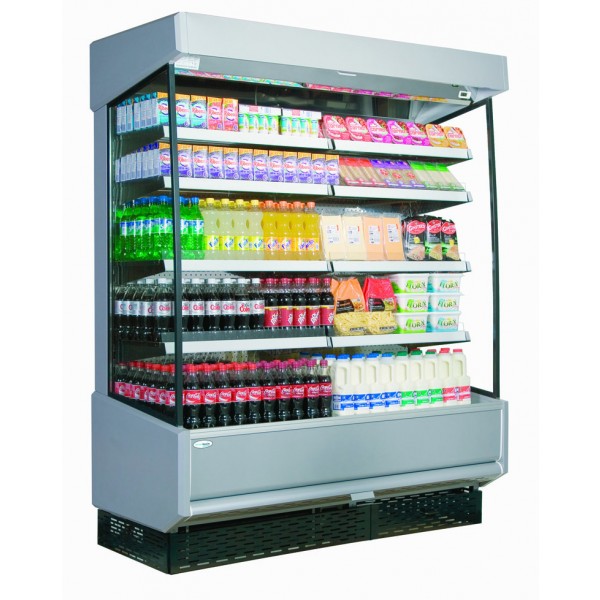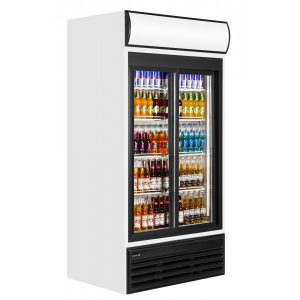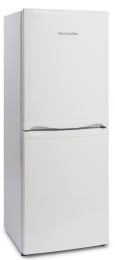
Refrigeration is key part of life in both the domestic market and commercial sector. Gone are the days of leaving milk on the doorstep or windowsill to chill it - refrigeration has come a long way. All models are designed to hold contents in cold temperatures to preserve and maintain freshness. This raises the question, if both household fridges and commercial fridges perform the same job, why not save a few pennies and choose cheaper domestic models when equipping your catering kitchen?
The answer is simple.
When setting up any business that prepares or stocks food for public consumption it is vital to purchase equipment designed for the specific task and built for purpose.
Here we highlight the main differences between domestic and commercial refrigeration.
Commercial
 |
Domestic
 |
| Suitable for frequent access: Can withstand doors being opened hundreds of times a day without any impact on performance or resulting in wildly fluctuating temperatures. | Suitable for occasional access: How many times do you open a fridge door in the home? 10, 20, 30 times a day? Domestic equipment is designed to hold temperatures based on infrequent access and opening of the door. |
| Size and capacity: There's a full spectrum of sizes and capacities to choose from. Whilst smaller, compact models are available, the majority of units will generate an increased capacity that can handle the massive demands made by large quantities of stock, necessary in foodservice businesses. Cold rooms and freezer rooms are also available which create a whole room dedicated to refrigerated storage. | Size and capacity: Most commonly domestic refrigeration consists of a 50/50 or a 70/30 split between fridge and freezer however single use models are available. |
| Temperature: Precision temperatures are key especially with regards to strict food safety standards. All equipment is guaranteed to meet and maintain temperature regulations and guidelines. Specialist temperature ranges are available for certain types of equipment such as -2° to +2°C for fresh meat and fish storage and ultra-low units operating lower than -30°C. | Temperature: Provides a broad temperature range that is suitable for all general purpose chilling and freezing. |
| Accuracy and precision: Thermostats used in commercial units offer greater precision and with simple to use controls and clear display, temperatures and conditions can be easily monitored for records. | Accuracy and precision: While low temperatures will be achieved according to settings, fluctuations will occur throughout operation. This slight variation in conditions shouldn't have any safety repercussions in a domestic environment. |
| Materials and manufacture: Constructed using high grade materials for added strength and durability to withstand tough professional environments. | Materials and manufacture: Materials used for construction and refrigeration components are not as durable as in commercial counterparts. |
| Efficiency: Units must undergo stringent testing to prove efficiency. Energy ratings are given in the form of MEPS (Minimum Energy Performance Standard) on some equipment (however will be rolled out to all equipment in the future). F-Gas Regulations are also in place to improve environmental awareness. Better insulation is in place and the design is geared toward efficient, energy saving operation. | Efficiency: Domestic energy ratings are given however testing isn't as rigorous. Insulation and design, whilst effective aren't of the same quality as commercial grade equipment. |
| Features: Will be dependent on the type of equipment. Features may include robust adjustable shelves, strong baskets, night blinds to cover open chillers during out of hours, locks, LED lighting, replaceable door gaskets, castors, adjustable feet, anti-mist glass, canopies plus many more. | Features: Will typically come with baskets, shelves or trays dependent on the type of equipment however these may not offer the strength and durability that commercial alternatives will. Internal lighting and adjustable feet are also typically available. |
| Power: Operates with increased power which delivers more accurate conditions, faster pull down of temperatures and greater consistency. Single phase, 13A supplies are catered for (with a standard three pin plug) on some equipment however larger models that require greater power will need either a single phase hardwired connection or a 3 phase supply. Integral or remote options are available. | Power: Not as powerful as commercial equipment. Will run using a standard three pin plug on a 13A supply found in homes. |
| Design: Refrigeration is available for every application whether undercounter, tall upright cabinets, counters, chests, drawers, multidecks or cold rooms, not to mention solid door or glass door display options. Units are designed for specific purposes such as for storage or display and to hold bottles, ice cream, meats or fish etc. Commercial refrigeration, dependent on the type may offer single door, double door or triple door options. | Design: Typically a tall upright fridge freezer combination with a solid door or in a chest layout. Undercounter and built-in variations are available as well as glass door models. Domestic models are typically for general purpose use and will have a single door layout, however larger double door 'American' style fridges are available. |
| Positioning: Equipment is designed for different placements. Serveovers and multidecks for example are ideal for front of house placement. Storage fridges and storage freezers are best placed in separate storage areas where ambient temperatures are less than 25°C. Catering fridges and catering freezers are designed to work in higher ambient temperatures and therefore are suitable for placement in hot commercial kitchens. Also check the climate class on any equipment as this will denote the maximum ambient temperatures and conditions in which a unit will efficiently operate. | Postioning: Will typically be placed in the kitchen, utility room, garage or outbuilding. Any deviation in ambient temperatures will be minimal and won't prevent placement in certain locations. |

Leave a Comment
Your email address will not be published. Required fields are marked *